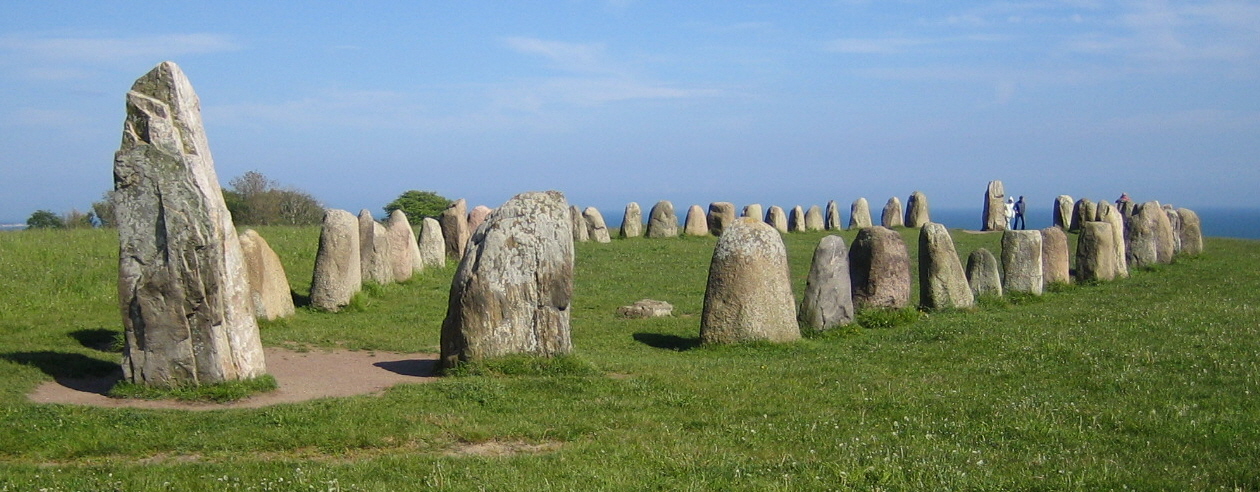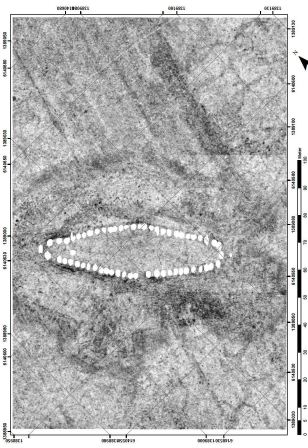

| Visitors Now: | |
| Total Visits: | |
| Total Stories: |

| Story Views | |
| Now: | |
| Last Hour: | |
| Last 24 Hours: | |
| Total: | |
A Swedish Stonehenge
Ale’s Stones (or Ales stenar in Swedish) is a megalithic monument in Skåne in southern Sweden. It consists of a stone ship 67 meters long formed by 59 large boulders of sandstone, weighing up to 1.8 tonnes each. According to Scanian folklore, a legendary king called King Ale lies buried there.

Credit: Användare:Jorchr
The carbon-14 dating system for organic remains has provided seven results at the site. One indicates that the material is around 5,500 years old whereas the remaining six indicate a date about 1,400 years ago. The latter is considered to be the most likely time for Ales Stenar to have been created. That would place its creation towards the end of the Nordic Iron Age
Credit: Swedish National Heritage Board
In 1989, during the first archaeological excavations performed in order to scientifically investigate and date the monument, archaeologists found a decorated clay pot with burned human bones inside the ship setting. The bones are thought to come from a pyre and to have been placed in the pot at a later date. The pot’s contents varied in age; some material was from 330-540 CE while a piece of charred food crust also found inside was determined to be from 540-650 CE. The archaeologists working on the project also found birch charcoal remains from 540-650 CE underneath an undisturbed boulder.

According to the Swedish National Heritage Board, carbon-14 dating of the organic material from the site indicates that six of the samples are from around 600 CE, while one sample is from ca. 3500 BCE. The diverging sample came from soot-covered stones that are believed to be the remnants of an older hearth, found close to the ship setting. On the basis of these results, the Swedish National Heritage Board has set a suggested date of creation for Ales Stenar to 1,400 BP, which is the year 600 CE.
In the 1970 Hasse Alfredson proposed a hypothesis that Ales stenar could have certain astronomical functions. With a common magnetic compas he established that the ship’s mid-line pointed towards the point of the horizon where the sun could be seen going up during both the summer and winter solstice. Göran Lind did measurements that gave further ground to this astroarcheological theory. Astronomer Curt Roslund proposed a theory that the ship’s long sides are constructed as parabolas that would allow one to measure the days left towards both solstices. The new visitor signs placed before the path to Ales stenar now provide empirical observations as to the possible astronomical function of the monument. There is continuous debate about the validity of these astroarchaeological assumptions.
Just northeast of the stone ship Ales stones, archaeologists from the National Heritage Board UV documented remains of a large stone tomb from the Neolithic times called ångdös or Swedish for long dead.
Bengt Söderberg and Bjorn Wallebom supervises excavation work at Ales stones.

Photo: Annika Knarr Power
The purpose of the study was to follow up the results of a geophysical exploration with ground penetrating radar and magnetometer carried out by UV Technology 2006th
Exploration generated data indicating that there just northeast of stone ship Ales stones may have been older funerary monuments in the form of a large stone tomb from the Neolithic to the Bronze Age overlaid by a high mound.
The archaeological investigation revealed that there was a north-south oriented burial spot. The traces of the approximately 20 x 8 meters large cairn which included the footprint for large ventricular blocks and curbs. As is often the case with dolmens were bargains material sparingly, a scratch, a chip and some rejection of flint. Långdösar dated generally to about 3500 years before Christ.
That there remainsfrom the bronze age at the site was more difficult to confirm.
- “We found the remains of the circular structure by way of the geophysical exploration but no startling remains were found. This may be because the area was cultivated for a long time before it was protected” says archaeologist Bengt Söderberg.
Excavation and the cleaning of facilities at Ales stones.

Photo: Annika Knarr Power
More stories
3 UFOs Found At Area 51 Using Google Earth, UFO Sighting, See Video
Hexagon Base Discovered On Moon’s Surface, Oct 20, 2012 Photos & Video
Three Giant Spaceships To Attack Earth In 2012?
Science and Astronomy
Unbelievably Stunning: Two Million Light Year Extragalactic Afterburner
DARPA Reveals HAARP Plans For 2013
Health
Difficulty Breathing, Chest Pain, And Cough Key Symptoms For Embolism
Excessive Daytime Sleepiness Common In High School Students
Mold Exposure At Home Could Increase Risk For Sarcoidosis
Chinese Herbs Show Promise For Lung Cancer, Flu, And Idiopathic Pulmonary Fibrosis
More UFO and Paranormal
Top Secret Photos Of Base On Moon Left On Desk While Press Takes Photo During 2012 Interview
10km Mothership Discovered In NASA Apollo 15 Archives! Confirmed!
UFOs Captured Over Mexican Volcano On National TV – October 11, 2012.
Wikileaks – Nibiru Planet X New Evidence 2012
UFO Swarm Sighting Over Noi, Vietnam, Oct 14, 2012, Video
Life Discovered On Mars By NASA Opportunity Rover, See Photos Close Up.
Doorway Into Moon Discovered in NASA Apollo Photos, UFO Sighting News.
Astronomy News
Earth Headed For Unavoidable Collision Say NASA Scientists
Solar Radiation Alert, Shock Warning With Real Time Tool
What’s Causing Turmoil On Jupiter, Planetary Changes, Bombardments
Where The Moon Really Came From
Sharpest View Ever Of Uranus And Its Weather
Science
Lethal Heat And The Greatest Extinction
Humans Flourished After The Ice Age And Before Agriculture
Did Hitler Escape To Indonesia? DNA Test Refuels Controversy
Does True Love Wait? Age Of First Sexual Experience Predicts Romantic Outcomes In Adulthood
Breakthrough Offers New Route To Large-Scale Quantum Computing
Health
The Common Cold, A Potential Ally In The Fight Against Cancer
UCLA Engineers Control Thousands Of Cells Simultaneously Using Magnetic Nanoparticles
Strange
Hexagrams In Google Earth Snap Shots: Images of a Stone Wall Warning System! And More





It’s not a henge. A henge is round and circled by a ditch and or bank, not boat shaped with no ditch or bank. This is most likely an elite viking burial.
Thus saith the expert.
These times referenced here
pre-date the Viking Era.